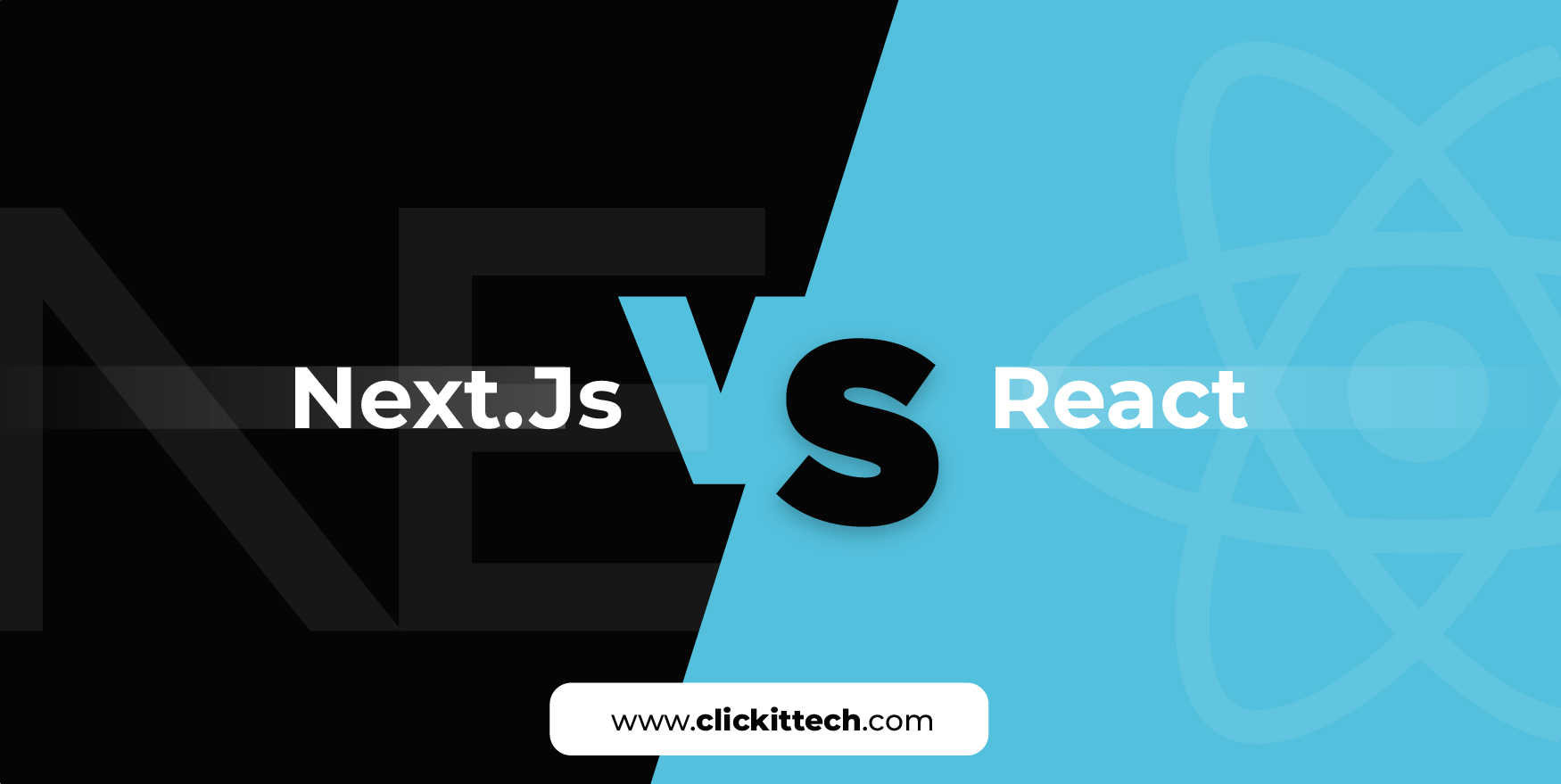Choosing between NextJs vs React is a tough nut to crack for many web developers and software development teams. As developers, we’re often spoiled for choice regarding tools and technologies. But, each project is unique and often requires a different approach and tech stack. That’s why we will discuss the next js vs react performance and more.
Although both Next.js and React are popular choices for web development in the JavaScript ecosystem, factors like project requirements, complexity, SEO, community, and learning curve are essential considerations that must guide your decision.
React is one of the most used libraries among developers, making it the usual go-to choice. But popularity doesn’t mean “suitable for your project.” Next.js builds on top of the same React library.
So, how are they different? Is Nextjs better than React, and which one should you choose?
- What is Next.js?
- Advantages of Next.js
- Disadvantages of Next.js
- What is React?
- Advantages of React
- Disadvantages of React
- NextJs vs React Comparison
- When to Use NextJs vs React
- Is Next js better than React?
- ClickIT Uses the Best Framework for Your Development Needs
- Conclusion of Nextjs vs React js
- FAQs
What is Next js?
Built on the React library, Next.js offers pre-built tools and functionalities, such as server-side rendering, static site generation, automatic code splitting, and hybrid rendering. It also supports features like hot module reloading and dynamic imports and provides serverless functions.
So, what is nextjs? Next.js is an open-source JavaScript framework created by Vercel that is for developing web applications.
Nextjs can be used to develop a wide range of web applications, including eCommerce platforms, real-time apps, and data visualization dashboards, among many others. It is a fast framework trusted by large, data-heavy, multi-user sites like Hulu, Netflix, TikTok, and Binance.
What are the Advantages of Next.js?
Now that we have established what is Nextjs, here are some of its advantages:
Speed
Due to the server-side rendering (SSR) and static site generations (SSG), Next.js applications are super-fast.
SSR renders pages on the server for each request, while SSG generates static HTML files at build time. The combination of these strategies allows for optimized page loading and performance.With the recent release of Next.js 14, it’s now poised to deliver even greater speed, thanks to the introduction of partial pre-rendering capabilities and an enhanced TurboPack.
Quick Setup
Most of the features in Next.js are built-in, so you don’t need a manual configuration or setup. For example, page routing and automatic code splitting are built without the need to write any code to create routes or optimize bundle loading in your app.
Built-in CSS Support for Seamless Integration
Next.js has built-in CSS support that allows you to add CSS stylesheets within a Nextjs project without using extra libraries or tools. This also means you can use the SSR and code-splitting features without concerns about properly processing your CSS.
SEO Optimization
Next ,.js moves the rendering to the server, so the client doesn’t need to process the information. In the next js vs react performance debate, This SSR approach is great for SEO because the server pre-renders the pages before sending the final HTML to the client.
That means less code to load, and users can expect a faster, lighter, and more user-friendly website. Ultimately, this gives you a better chance to rank your website and web application on search engines.
Custom Back-End Functionalities
Another reason why Next.js is beneficial to developers is that it allows them to create and implement custom back-end functionalities for the front end through serverless functions or API routes.
This doesn’t affect the size of the client-side application bundle. Instead, it ensures efficient client-server communication and maintains a streamlined front-end.

What are the Disadvantages of Next.js?
When deciding between Nextjs vs React js, it’s important to consider their disadvantages as well. Here are some of the drawbacks of Next.js to consider:
File System-Based Routing
Next.js’ conventions and file system-based routing may need to be improved for some advanced use cases or project structures. This limits flexibility and developers often need expertise with Node.js tools to develop dynamic routes.
Limited Customization
Despite its high extensibility, developers may need to work within Next.js’s constraints, making it difficult (but not impossible) to implement specific design choices or features.
Community Support
Although it’s growing, Next.js has a smaller community than React. This means as a developer, finding support or resources is relatively more difficult than it would be if you were using Reactjs.
Code Bloat
Next.js may introduce code bloat when unused features are included, especially for simple projects. And in the react vs next js performance, this can potentially slow it down and complicate maintenance. Proper configuration and optimization are key to mitigating these issues.
What is React?
React, also known as ReactJS, is an open-source JavaScript library developed by Facebook (now Meta). It is designed for creating reusable and intricate user interface (UI) components used in web, mobile, and desktop applications.
React follows a component-based architecture, allowing developers to assemble reusable components for single and multi-page applications.
React also uses a virtual DOM (Document Object Model), ensuring efficient rendering and a declarative syntax. This simplifies application state management and UI updates for developers.
Contrary to what many devs call it, React is a library rather than a comprehensive framework. So, it can be used with other libraries, frameworks, and tools like Redux, Axios, and React Router to build full-stack web applications.
As the most commonly used JavaScript framework after Node.js, React is like the Swiss Army knife of web development. Its versatility, compatibility, and extensive community support and ecosystem make it a popular library for developing websites and web applications.
Discover our React.js development services now!
What are the Advantages of React?
For such a popular and widely adopted library, you’d expect many benefits of React. Here are some of them:
Reusable Components
React components are reusable, meaning they can be loaded onto different pages repeatedly without losing their characteristics. You only need to modify the component code, and the changes will be visible across all pages.
Extensive Community Support and Ecosystem
Due to a rich and thriving community of developers and contributors, many resources, support, and learning docs are available. So, as a React developer, you always know where to look if you run into a problem.
Easy and Faster Development
React makes it easy to develop web applications, particularly since it’s JavaScript-based. This allows developers to quickly build dynamic websites and web apps using less code and a familiar language.
Customization
Being a library, React has a set of features and functionalities that can be expanded by using tools like Redux, Mobx, and Avios.
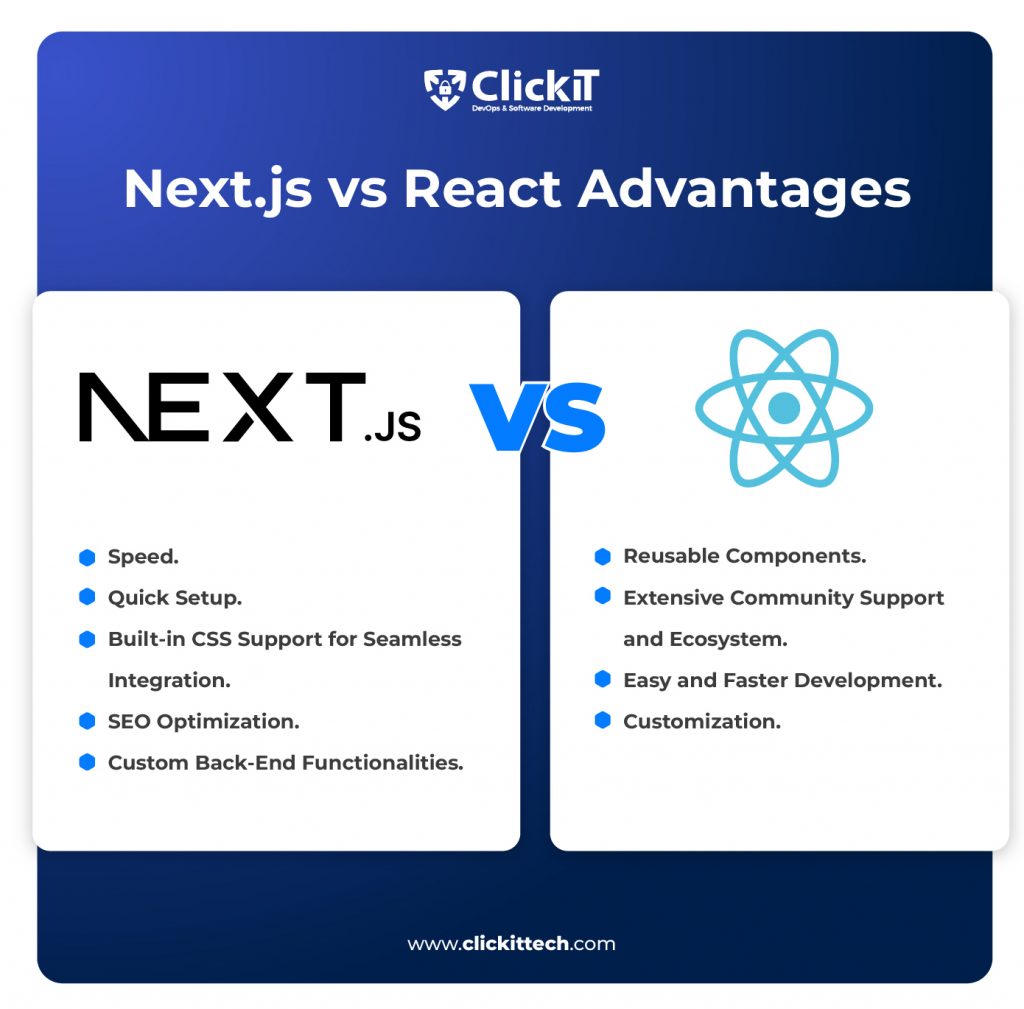
What are the Disadvantages of React?
Although it’s a widely adopted library, React does come with some drawbacks that you should know:
Frequent Updates
React’s active community and frequent updates ensure that the library remains up to date with the latest web development practices. However, this can also require developers to learn about new features and security patches in each release. For example, React has had up to nine versions in the last three years alone.
Limited Features
React is primarily a UI library that doesn’t have built-in support for functionalities like application state management, routing, or form handling. Although it offers flexibility to choose your preferred tools, it also means you need to integrate additional frameworks or libraries to implement these essential features.
SEO Challenges
React applications are often single-page applications (SPAs), and they may require extra effort to implement server-side rendering for better SEO. Without SSR, search engines may have difficulty indexing the content.
Performance Optimization
React is generally performant, but achieving optimal performance in complex applications may require extra effort and in-depth knowledge and optimization techniques.
Boilerplate Code
Complex React.js projects often require additional boilerplate code, increasing the overall codebase size and development time.
Are you looking to hire a React developer, or is React a part of your tech stack for an oncoming project? ClickIT is your trusted partner! With more than a decade of experience in React web development, our developers can take your product from ideation to deployment in record time.
Next js vs React Comparison
Now that we know the pros and cons of Next js vs React js, it’s time to compare them using certain prerequisites. We’ve chosen the following requirements because they are significant considerations for most developers and software teams when choosing between Nextjs vs React js.
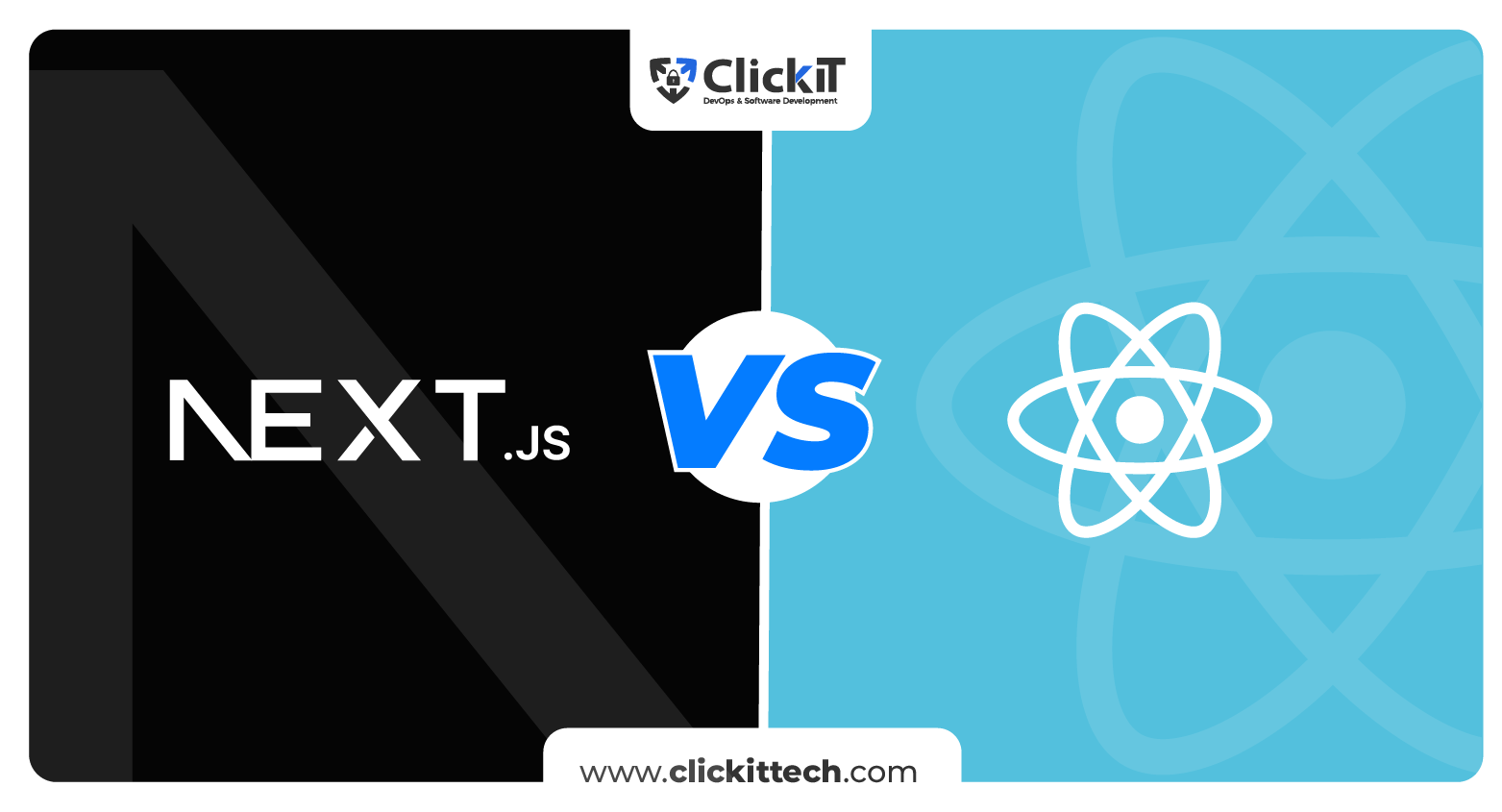
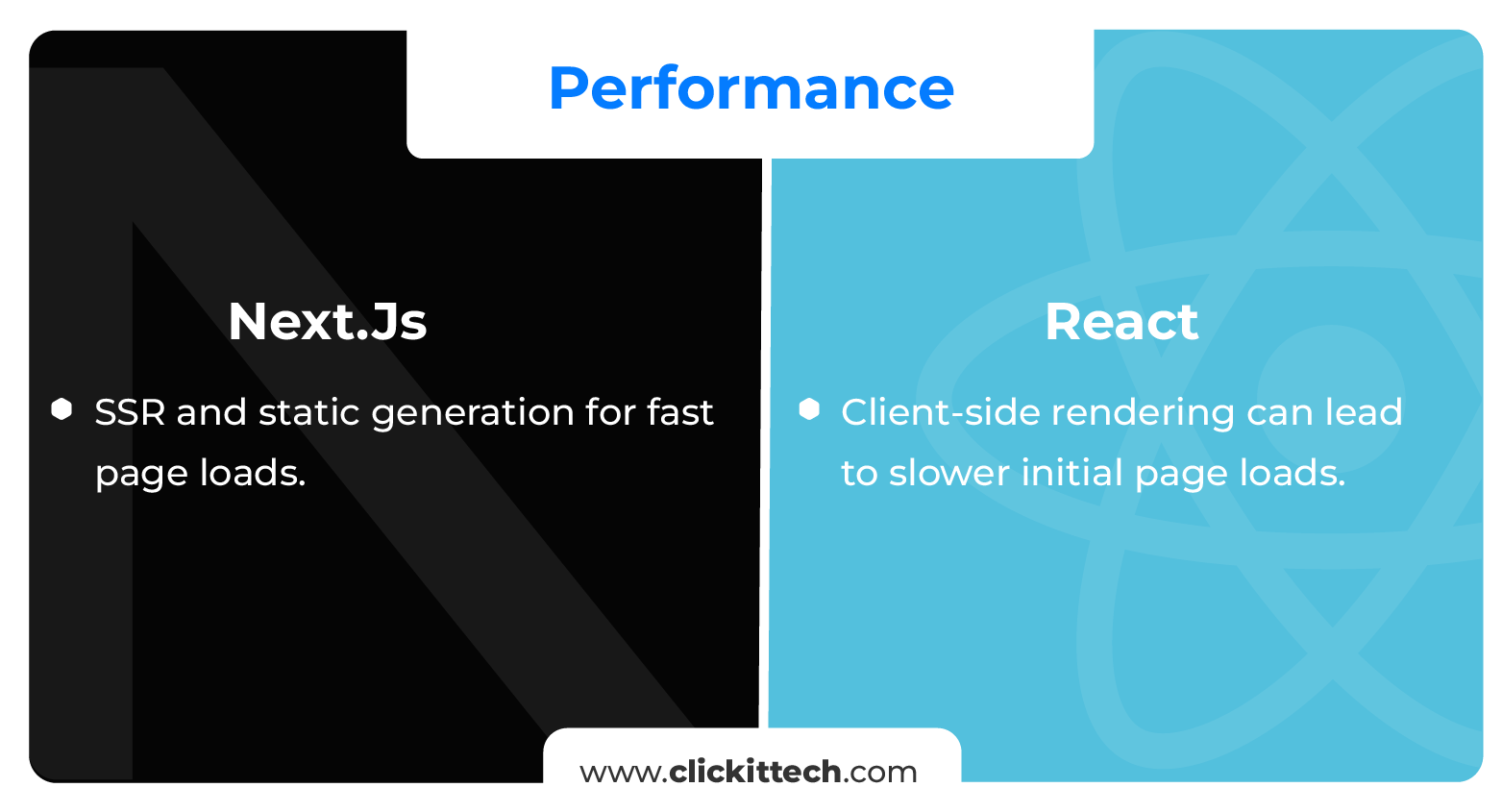
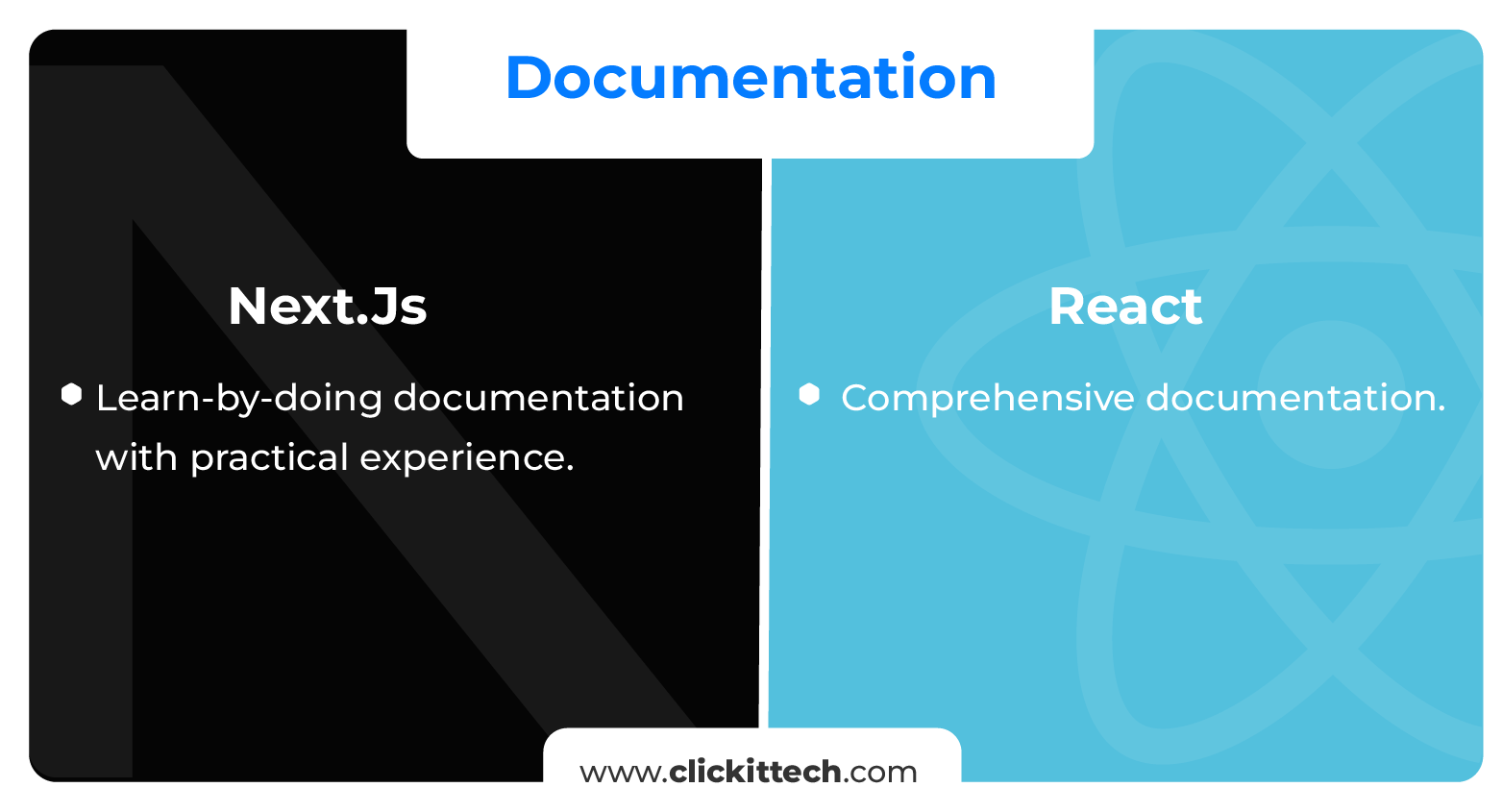
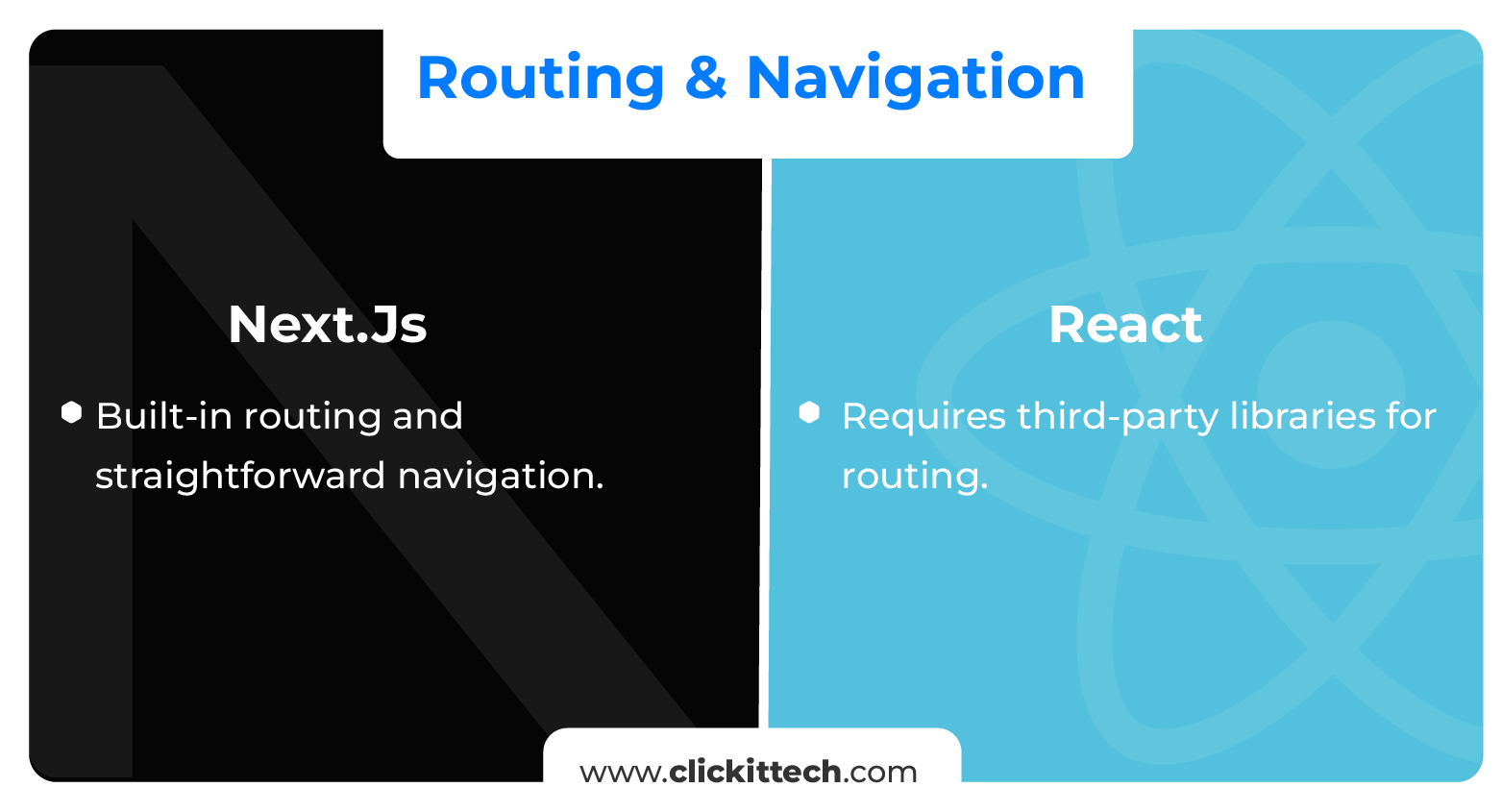
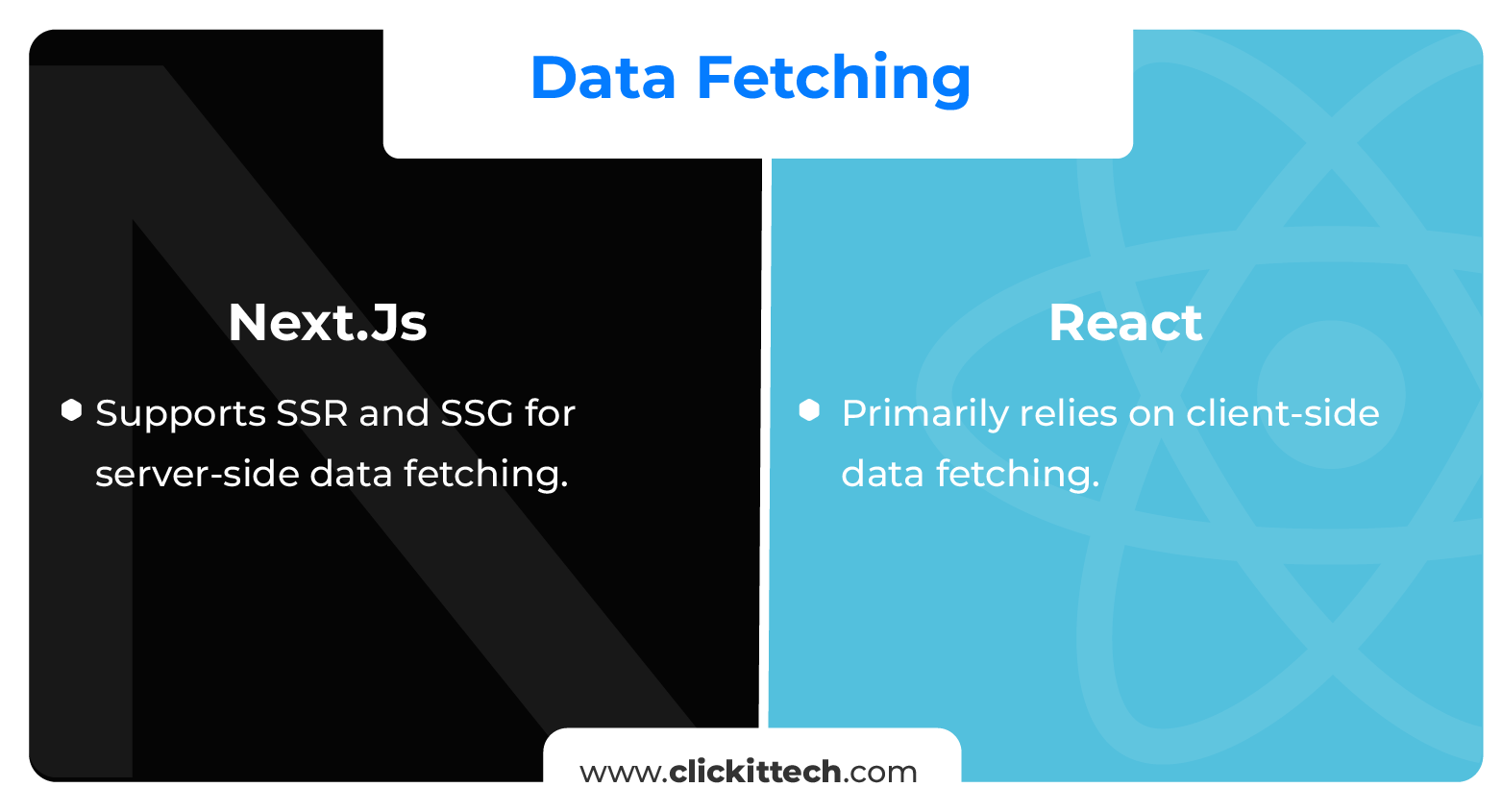


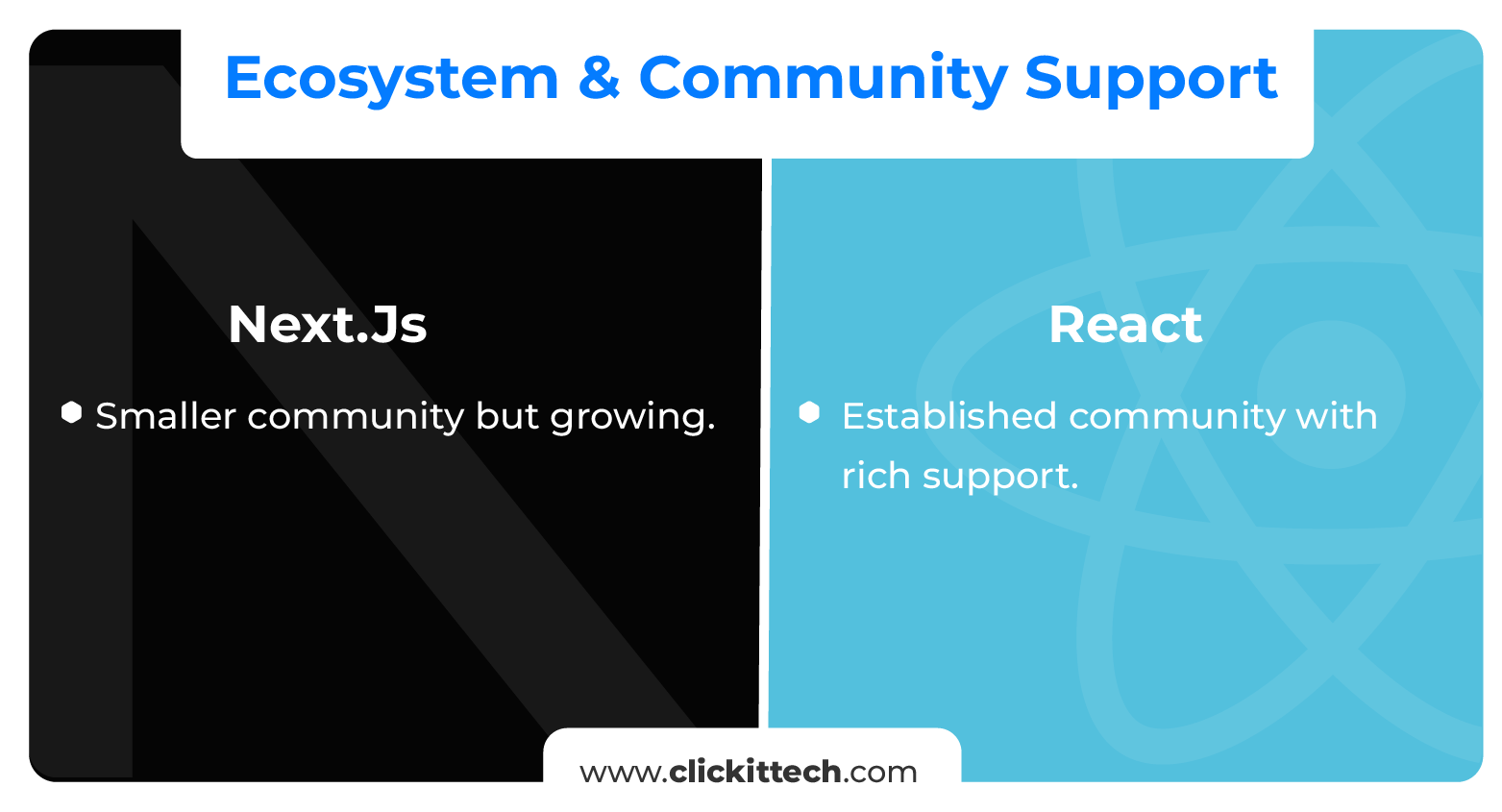

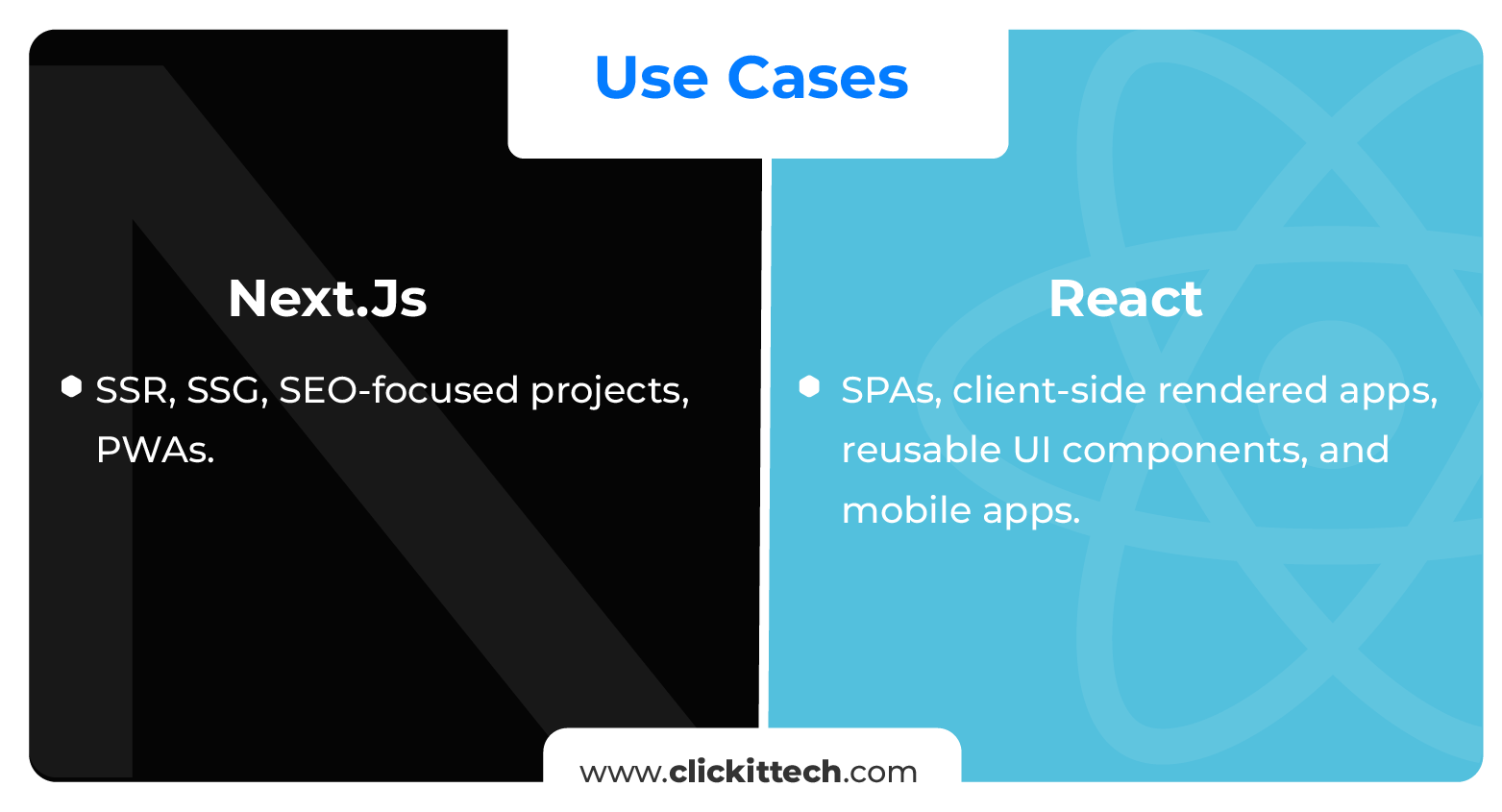
NextJs vs React Performance
When comparing NextJs vs React, performance is likely one of the biggest considerations for developers.
Next.js websites and web applications use server-side rendering and static generation, making them extremely fast. This is an efficient way to handle data because the pages are pre-rendered in build time, cached, and served over a CDN.
Performance enhancement features like native image optimization and automatic code splitting also improve performance.
On the other hand, React isn’t as fast as Nextjs because it uses client-side rendering. This means the initial HTML page sent to the browser is minimal, and the content is populated on the client side with JavaScript.
Although client-side rendering may deliver a smooth and dynamic user experience (UX), the tradeoff is it can potentially cause slower initial page loads, especially if the user is on a slower connection or less powerful device.
However, in the next js vs react performance debate, React can still be considered to use other rendering methods that can improve its performance. But as a developer, you know that’s extra work for you!
NextJs vs React Documentation
Documentation is a key consideration for developers when choosing a technology, language, tool, library, or framework.
Next.js has learn-by-doing documentation on its website, a helpful resource for developers. It provides understandable step-by-step instructions and practical experience to help you use the tool. This makes it easy to quickly hit the ground running and build your Nextjs applications once you complete the docs.
The React documentation is also easy and comprehensive. There are tutorials, articles, and videos that cover all the basics you need to get started. React’s active and large community also continuously updates the library and the docs, making it easy to solve any problems.
So, regardless of your choice between React vs Next.js, you will find detailed and useful documentation.
NextJs vs React Routing and Navigation
Next.js provides built-in routing and navigation. You define your routes as files and folders, which makes it intuitive and easy to organize.
Navigation between pages is simple using the built-in <Link> component, an extension of the HML <a> tag. It handles route-based code splitting for faster page loads. This approach simplifies route management and makes client-side navigation snappy.
React, on its own, doesn’t include built-in routing. Developers often use third-party libraries like React Router to handle routing in React applications. It allows you to define routes, handle navigation, and pass parameter URLs.
While this gives you flexibility and control, it also means you need to set up and manage routes independently, which can be more work.
NextJs vs React Data fetching
Next.js supports server-side rendering (SSR) and static site generation (SSG) out of the box. This means you can fetch data during the rendering process on the server (request time), which can improve initial page load times and SEO.
To fetch data on request, you can use `getServerSideProps` for SSR and `getStaticProps` for SSG.
React, by itself, primarily relies on client-side data fetching. You make API calls from the client using Fetch API or Axios. While this is straightforward, it can lead to slower initial page loads because data is fetched after the page is rendered.
You need additional tools or frameworks if you want to use server-side rendering in React.
NextJs vs React Server-side Rendering (SSR)
We’ve already established that Next.js offers server-side Rendering – you don’t need any configuration.
By default, React doesn’t support SSR. While this can be enabled, it might take some work to integrate and set up SSR with your preferred server.
NextJs vs React Maintenance
Since Next.js comes with built-in solutions for common tasks like SSR, SSG, and routing, you’ll generally need fewer custom configurations, which can make maintenance simpler.
On the other hand, achieving optimal performance in React often requires manual optimization, like code splitting and image handling. This can demand ongoing maintenance to ensure your app remains fast and efficient.
While Next.js and React have conventions on their Create a React App (CRA), they’re well-maintained and release frequent updates.
NextJs vs React Ecosystem and Community
React has been around for a decade, so it’s already established with a rich community of developers and contributors. And they continually contribute to the library’s improvement.
This also means React is compatible with many other tools and frameworks that extend its capabilities. So, it’s easy to find support, learning documentation, and resources whether you’re a beginner or a professional.
Next.js’ community is small compared to React. However, it is growing – from being ranked as the 11th most popular web technology to 6th in 2023, it’s clear that in the coming years, it could have a community as strong as React.
Next.js vs React Learning Curve
Both Next.js and React are based on JavaScript, meaning you need a good understanding of JavaScript to use any of them. However, their learning curve varies depending on the individual.
Some developers will say Next.js’ structured learning path can make it easier for beginners. At the same time, React may have an approachable entry point, but it gets trickier when you dive into complex apps or encounter concepts like JSX syntax or component-based architecture.
On the other hand, others may say React is easier to learn because Next.js builds on React and adds more features, making it a full-fledged framework as opposed to React being a library.
Read our blog React vs Angular to learn more about web frameworks
When to Use Next.js or React?
Another important area to consider when comparing NextJs vs React is their use cases. In the following sections, we’ll discuss the scenarios where either Next.js or React would be recommended.
When to Use Next.js
You should consider using Nextjs over React in the following cases:
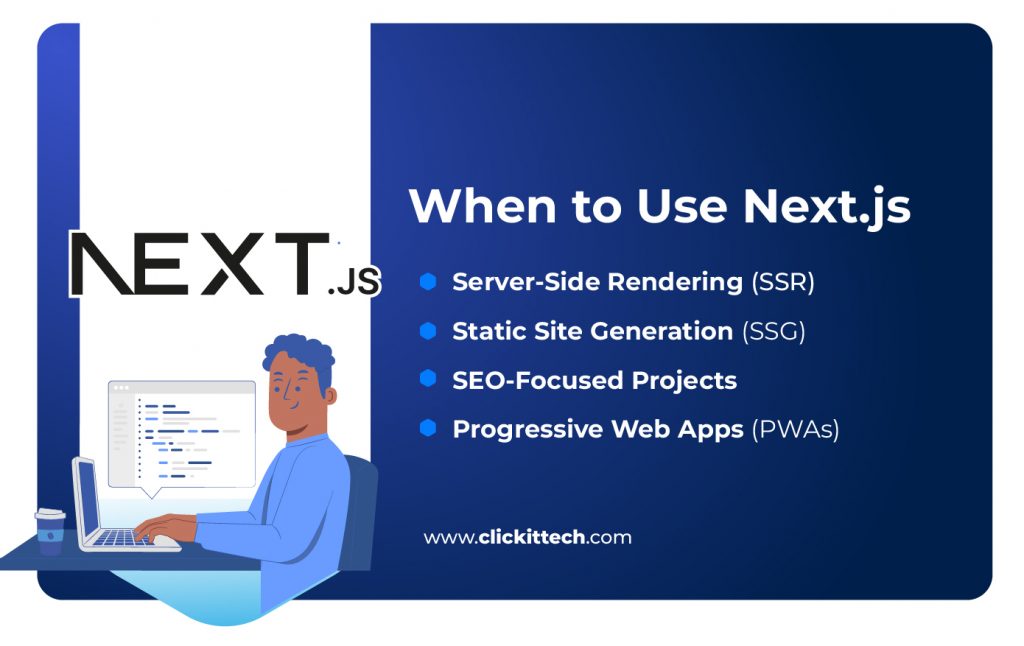
- Server-Side Rendering (SSR)
If you’re building a website or web app and server-side rendering (SSR) is crucial, Next.js is the better option. It’s your go-to for faster initial page loads and for developing dynamic content with changing data.
- Static Site Generation (SSG)
For content-heavy sites, blogs, or eCommerce, choosing Next.js guarantees speed. Its SSG feature pre-generates pages during build time, loading them almost instantly.
- SEO-Focused Projects
If the decision between NextJs vs React is based on SEO-friendliness, then Next.js has the edge here.
Although React websites can also be SEO-friendly if properly optimized during development, Next.js’ rendering of web pages on the server side rather than the client side boosts SEO performance.
This feature allows search engine crawlers to scan and index your web pages faster, detect metadata, and understand the information on a website.
- Progressive Web Apps (PWAs)
Nextjs is an excellent choice for building Progressive Web Apps with a native app-like experience.
You can even integrate service workers to improve your app’s functionality and UX, enabling your app to work offline, load quickly, and deliver a reliable user experience.
When to Use React
Thinking of you using React in your next project? Here are scenarios we believe React has the edge over Next.js:

- Single-Page Applications (SPAs)
React is the better option when developing user interfaces for single-page applications that run entirely in the browser. This is because it works the layer of web or mobile apps, allowing you to create more visually appealing and intuitive applications.
Plus, React’s component-based architecture and virtual DOM make it well-suited for managing complex user interfaces in SPAs.
- Client-Side Rendered Applications
If you prefer the client-side rendering approach, React is the way to go. React enables you to build apps that render and update content on the client side, creating a smooth and dynamic user experience.
- Reusable UI Components
React is a fantastic option for building reusable user interface components. It promotes component reusability and modularity, which saves time and effort when creating and maintaining UI elements across your application.
Additionally, reusable components give your app a consistent look and feel, ensuring design uniformity and a good user experience.
- Mobile App Development
Thanks to React native, React is an excellent option for mobile app development. With React Native, you can write code once and deploy it on iOS and Android platforms, streamlining the development process and reducing maintenance overhead.
So, if you’re building a mobile app and the question is Next.js vs ReactJs, the latter is the answer!
Is Next js better than React?
Nextjs vs React js are not directly comparable in terms of being “better” than each other because they serve different purposes within the web development ecosystem.
React can be used to build single-page applications (SPAs), progressive web apps (PWAs), and mobile apps using React Native.
Next.js, on the other hand, is a React framework for building server-side rendered (SSR) or statically generated web applications.
The best option between Nextjs vs React js depends on your project’s specific requirements and your goal. Next.js builds on React and is excellent for server-side rendering and routing, while React is a library for building user interfaces. Here are the factors you should consider.
| Parameter | Next.js | React |
| Performance | Server-side rendering (SSR) and static generation for fast page loads. | Client-side rendering can lead to slower initial page loads. |
| Documentation | Learn-by-doing documentation with practical experience. | Comprehensive documentation with active community support. |
| Routing & Navigation | Built-in routing and straightforward navigation. | Requires third-party libraries (e.g., React Router) for routing. |
| Data Fetching | Supports SSR and SSG for server-side data fetching. | Primarily relies on client-side data fetching. |
| Server-Side Rendering | Offers SSR without additional configuration. | React supports SSR but requires extra setup and integration. |
| Maintenance | Built-in solutions for common tasks reduce custom configurations. | Built-in solutions for everyday tasks reduce custom configurations. |
| Ecosystem & Community Support | Smaller community but growing. | Established community with rich support and resources. |
| Learning Curve | The structured learning path may be easier for beginners. Additional features may be tricky for some learners. | It is an approachable entry point, but complexity increases with advanced usage. |
| Use Cases | SSR, SSG, SEO-focused projects, PWAs. | SPAs, client-side rendered apps, reusable UI components, and mobile app development. |
ClickIT Uses the Best Framework for Your Development Needs
Choosing the right framework for your software development needs can be a long and often stressful process; you have to keep in mind Nextjs vs React js performance and more factors because the wrong framework can complicate the development process and limit the scalability of your website or web app.
ClickIT takes this stress out of the way and provides best-in-class DevOps, software development, and staff augmentation services. Leveraging more than ten years of experience and 50+ certified AWS Engineers, we’re equipped to choose and use the best framework and technology stack that suits each project’s unique needs.
ClickIT has helped more than 500 small to large-scale companies bring their project to life from ideation to final deployment and maintenance.
Have a project idea in mind? We can help you develop, launch, and scale your software to success. Let’s talk!

Conclusion of Nextjs vs React js
Next.js and React are popular platforms in the JavaScript ecosystem, meaning a strong understanding of the programming language is essential before using them.
On the one hand, Nextjs’ SSR and SSG capabilities ensure extremely fast apps and the built-in solutions for common tasks simplify maintenance.
On the other hand, React’s rich ecosystem and community, usage in mobile app development, and reusable UI components enhance modularity and consistency across your application.
Ultimately, choosing between Next.js vs React performance depends on many factors, including the specific use case, preference, and the developer’s expertise.
Next js vs React js FAQs
React is a library and not a framework. It is a JavaScript library for building websites. However, its “Create React App” provides tools and configurations to help you quickly set up a new React application.
No, Next.js and React are not the same. React is a JavaScript library for building user interfaces. Next.js is a framework built on React with additional features like server-side rendering and automatic code splitting.
The best option between Nextjs vs React js depends on your project’s specific requirements and your goal. Next.js builds on React and is excellent for server-side rendering and routing, while React is a library for building user interfaces. Choose based on your specific needs.
If you’re new to both, start with React JS to learn the fundamentals of building user interfaces. Once you’re comfortable with React, you can explore Next.js for server-side rendering and routing.
It’s not a strict requirement, but it is helpful. Knowledge of React is essential for effectively using Next.js, as it extends React’s capabilities with server-side rendering and other features.
Next.js is an open-source JavaScript framework created by Vercel and used for developing web applications.
Nextjs can be used to develop a wide range of web applications, including eCommerce platforms, real-time apps, and data visualization dashboards, among many others.

